When DEI is the Solution and the Problem
“Maybe the problem isn’t us; maybe the problem is DEI.”
This thought kept circling in Amy’s head as she left the meeting with her Board’s Executive committee. The Board wanted a clear outline of the next steps to turn the culture around now that it looked like Amy’s DEI push had significantly stalled.
In the five years Amy had been CEO of her organization, the last three were the hardest. Not only was she making a concerted effort to drive DEI work forward, but she was also dealing with the logistics and unexpected shift of her organization going fully remote during the pandemic. A shift that ultimately was failing.
Team members had initially shared excitement for a workplace with more flexibility, but the broader working culture quickly turned sour. Between new hires who never got face time with their teams, and everyone else whose work relationships and flow started trending toward disconnection and low trust, there was a lack of engagement.
After a push from the Board chair that building a DEI program would fix this culture issue, she invested in hiring a DEI Lead and external consultant. She frequently engaged with the org’s DEI council, proudly approved their suggestions for fair compensation policies, and noted more racial diversity in their hiring.
Everything should be all good, right?
Yet, the last organization-wide survey results reflected that people did not believe they were making meaningful strides in DEI and culture. Team members consistently cited in their exit interviews that culture was their reason for leaving.
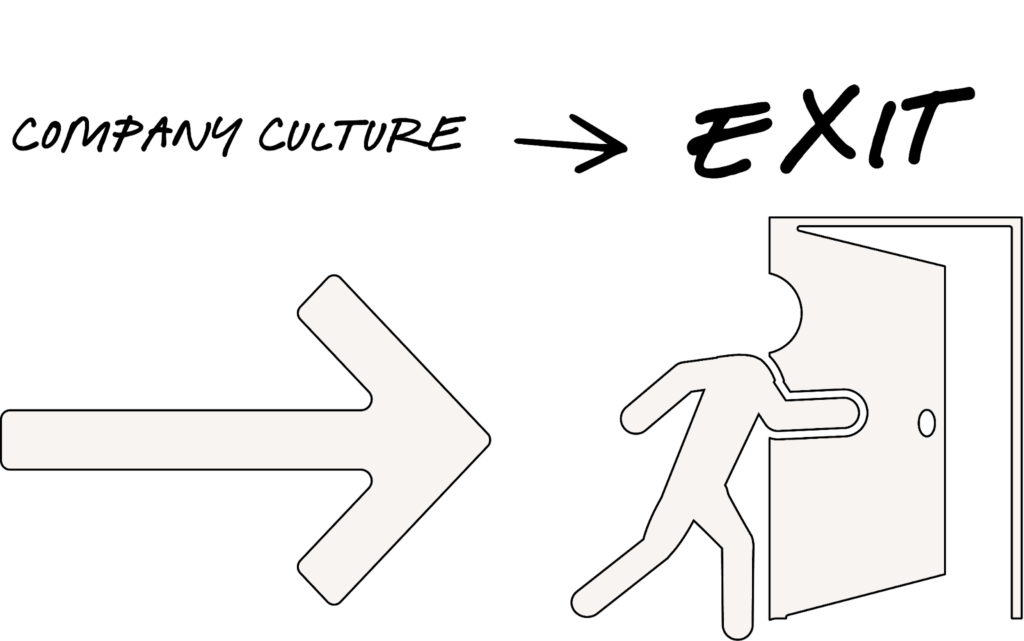
After listening to the Board’s frustrations and concerns, Amy started to reflect on how easy it seemed to be to lead the organization before introducing all these DEI initiatives.
“How much longer before my job is in jeopardy?” she wondered. “And, is this DEI work making us better, or . . . is it simply distracting us?”
—
Diversity, equity, and inclusion (DEI) is the solution most organizations need, but how it’s currently understood and implemented also makes it the problem.
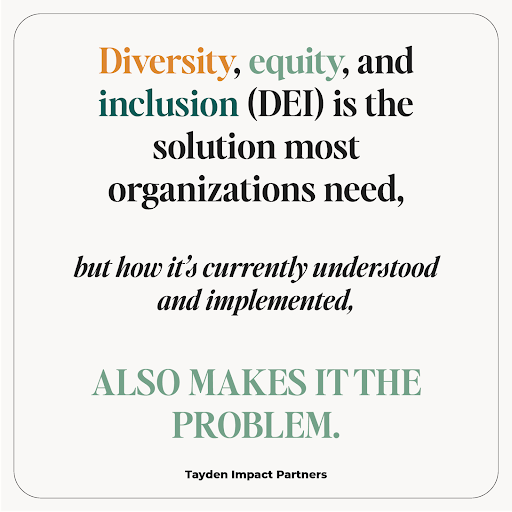
It’s like the couple that gets counseling to strengthen their relationship, even though they don’t believe anything is seriously wrong.
When the counselor starts asking very specific questions, and in the words of one of the partners in the relationship, “poking around inside their heads where they don’t belong,” problems start to surface.
One person realizes they don’t feel supported enough. The other brings up that the first one’s tone is often too sharp. And so on, and so on.
Did the counseling cause the problems, or did this couple already have deeply rooted trust issues and values misalignments lurking under the surface of their daily interactions?
In a scenario like this, it’s easy to imagine that the couple had issues they just didn’t understand the effects of, or want to talk about, or grasp the seriousness of. An experienced counselor can observe patterns, language, behaviors, and emotions behind words. That same counselor can also put labels on those feelings and issues to help the couple understand them better.
But certainly, to one or more people in a relationship, it could seem like the counseling caused the problems.
And imagine if you had a misguided counselor? Someone who brings up the right things in the wrong way and the wrong things in a convincing (right) way.
What hope is there, then?
Allow me to non-subtly segue to DEI work and DEI consultants, councils, and other directors.
I have led and consulted on DEI in impact organizations ranging from 25 to 2,000 people across various mission-oriented focuses. What most people consider to be DEI work is based on an outdated concept that leads it to be more of a problem than a long-term solution.
The DEI of Old…
When DEI was first introduced into organizations in the 1960s, the focus centered on affirmative action and ensuring that gender and racial diversity were expanded from a compliance lens.
Where it fell short in the ‘60s is similar to what we’re continuing to see today—DEI is still centered on theory, feeling, and short-term initiatives instead of long-term, sustainable business practices that can be felt throughout every part of an organization
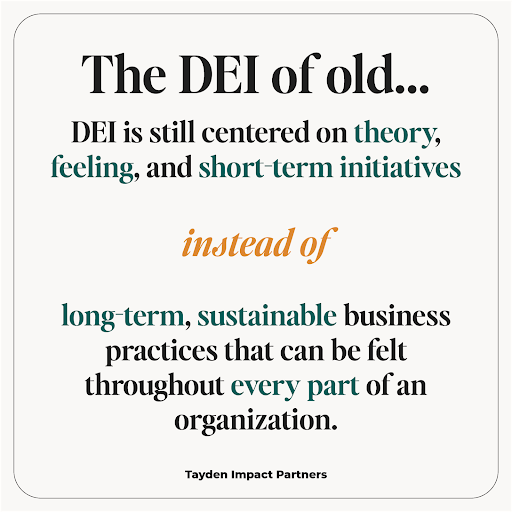
The DEI of old and today are still seen and positioned as initiatives, programs, or strategies rather than how to work daily.
Imagine if our couple treated love and honesty as a project instead of learning to operate in honesty, trust, and gentleness as a part of their values and commitment toward the person they love.
Or imagine if they “went through the motions” and had a date night every month and asked each other how their day was each day, even though they were profoundly disengaged and mistrusting?
With this couple, and with every single organization trying to do good DEI work, the question becomes:
Does implementing short-term DEI initiatives change hearts and minds?
Over the years, especially since 2020, we’ve seen a desire to shift DEI from theory to action. This has led to many organizations launching DEI initiatives that changed a minor piece of the business temporarily (like a single compensation policy, a change in the mission statement, or a 5-year plan for equity in hiring practices) but never actually reached the core of the way that they were intended to.
And in many cases, the sheer number of initiatives (that lead to no sustainable changes in outcomes) have led teams to feel more disillusioned and frustrated by DEI than encouraged and hopeful.
Organizations are coming to recognize that:
While also being more clear that DEI is not designed to bring that substantive change that is needed:
We need movements, not projects.
We’ve built DEI infrastructures and systems that are in direct tension with how organizations work and expect leaders and consultants to figure out how to move from tension to alignment overnight. This flawed thinking leads to organizations and leaders feeling more tension, stress, and pain from introducing DEI into their work instead of joy and excitement.
It becomes the thing that everyone is least excited to talk about because its current design doesn’t work with how we work. And yet, DEI leaders, consultants, and experts continue to preach that we need to shift to action and embed DEI into organizations, even if we are trying to fit a rock into a pegged role.
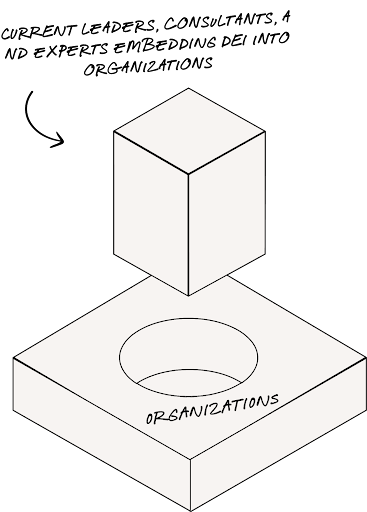
The Organizational Culture of Old…
In this post-pandemic space, organizations have grappled with how to move forward with the sudden changes the pandemic forced them to make. All at once, there were hybrid and remote teams, in addition to a resurgence in social justice work in the workplace, and people inside these organizations who seemingly cared more deeply about their work experience than ever before. People are looking for a place that understands that “the balance of power has shifted from employers to employees.”
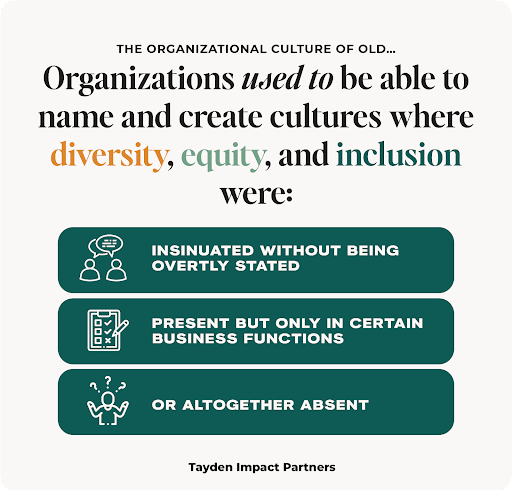
Organizations used to be able to name and create cultures where diversity, equity, and inclusion were:
- insinuated without being overtly stated
- present but only in specific business functions,
- or altogether absent.
Now, organizations are rushing to figure out how to bring DEI into their culture, align it with all of the other shifting pieces of the work environment, and do so in a way that resonates with their current team quickly, or face the impact of constant turnover, inability to hire, and the need to put even more energy into the employee experience than the mission-focused work they were founded to do.
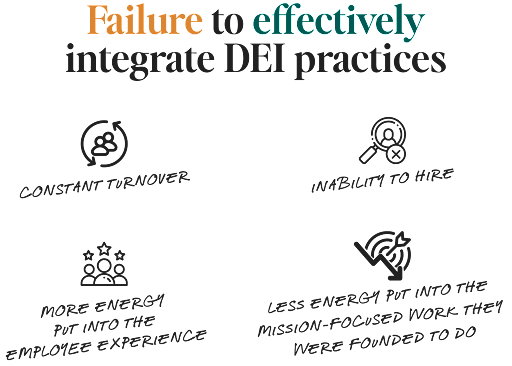
Organizations need a DEI Culture Shift.
“Organizational culture is generally understood as all of a company’s beliefs, values and attitudes, and how these influence the behavior of its employees.”
So what’s a DEI Culture Shift?
This is one where every shift, whether structural, systemic, or cultural across the business, is done to ensure prioritized diversity of perspective, lived experiences, and equitable and inclusive business practices. It ensures that as an organization’s culture shifts over time, it keeps an inclusive experience at the forefront of the work.
It is about making DEI a core value instead of a program or initiative.

An organizational culture that centers DEI at the core can fundamentally shift how the company operates.
For example, an organization with a culture that centers and values DEI is more likely to attract and retain a diverse workforce. This can lead to a culture that promotes equity and supports the development of all employees. In contrast, a culture that needs to be more inclusive may need help attracting and retaining diverse talent, which can perpetuate a lack of diversity and limit opportunities for underrepresented groups.
It is no longer about just having an innovative culture, for example; it’s now about having a culture where everyone can innovate equitably.
These meaningful differences seem small and easy to shift on paper. Yet, when coupled with the nuances of figuring out how to make this shift while also running a business that is operationally sound and is meeting the needs of the people they are intended to serve externally, it becomes clear that this is going to take more than a simple choice of new words and phrases.
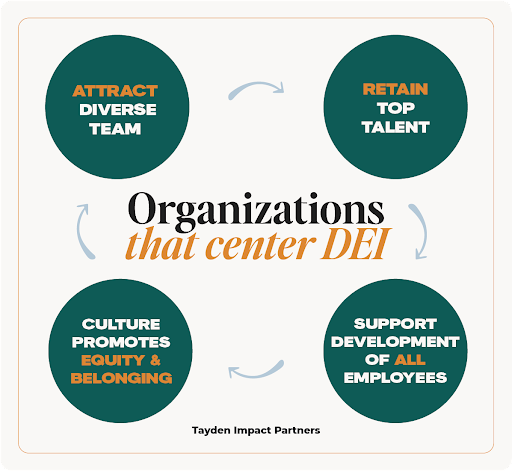
Organizations must examine their entire operational model from the inside and out and be prepared to shift to the working culture, employee experience, policies, practices, and systems built initially pre-pandemic.
Between the DEI of old and a culture that no longer serves the organization’s mission, post-pandemic, we are making organizations more stuck than they were before.
And no one wants to be permanently stuck.
Where Has This Gotten Us?
How we’ve understood and executed DEI has left many organizations stuck and, in the case of many CEOs, disillusioned with DEI’s role in shifting culture.
Headlines have shifted from “How do we engage in DEI?” to headlines focused on trying to understand “Why are DEI roles disappearing?” Or headlines that highlight problems the poor execution of this work has caused: “Companies committed to DEI. Then the Layoffs started.”
Some of the failures of DEI work were due to false intentions (organizations who developed initiatives and DEI councils to respond immediately without any real purpose of doing concrete work around it). Still, I believe those companies are in the minority and that most organizations had genuine intentions, attempted to “do DEI” as it’s currently designed, and ended up in the same place that our example CEOs did: stuck.
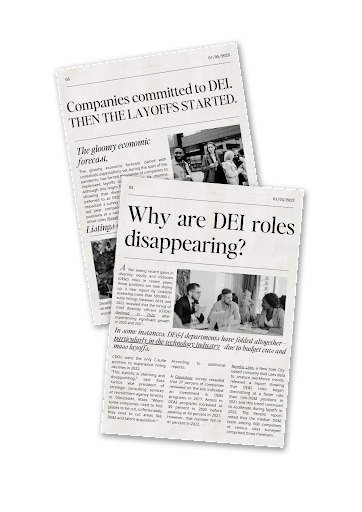
More leaders are beginning to position DEI as the problem instead of understanding that (1) DEI can be the solution for shifting the core operational culture of a business, but (2) just not in how it’s designed today.
Amy is right: Right now, DEI is the problem.
So, what do leaders like Amy do?
Well, first, there are three honest conversations they need to have.
And to get to those, let’s summarize where we are…
- Many CEOs are committed to DEI but need clarity on concrete ways to lead the movement that brings DEI to life across their organization.
- Organizations believe that the answer to solving their post-pandemic culture gaps is DEI, but they don’t realize that in its current form, DEI brings more challenges and misalignment than it does clarity and a path forward.
- DEI Leaders inside orgs are exhausted from being stuck on a constant wheel of trying to get people committed, having initiatives launched only to be stalled, and being pushed to accept that their work is more about sharing theories and changing mindsets than driving action. So, they often leave their roles without making meaningful progress.
- In many companies, there is a lack of accountability across the organization because most people don’t have the time or budget to add another initiative to their plate.
- DEI committees are created with short-term, finite goals in mind and need more clarity and expertise to drive work forward in the long term.
- Everyone (Business and DEI Leaders) says we “need to do the work,” but no one knows what the work is and why they should do it. What does embedding DEI actually do for the organization?+
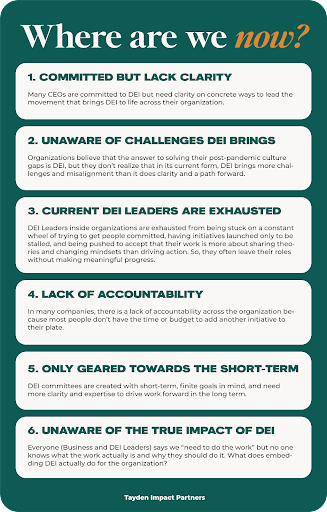
Organizations believe DEI is the right solution to gaps in operations, experience, and impact, but when DEI fails, it becomes the right thing to blame and walk away from.
It leaves organizations in the same place where they started, or in some cases, worse, as teams are scarred from DEI training and initiatives that opened up a can of worms and left them with no instructions on what to do next.
And it leaves organizations with an impact-focused mission spending more time trying to understand how to rebuild the inside of the organization instead of on the work they were created to do.
It’s complex, messy, and leaves a lot of pointing fingers, often at the team leader.
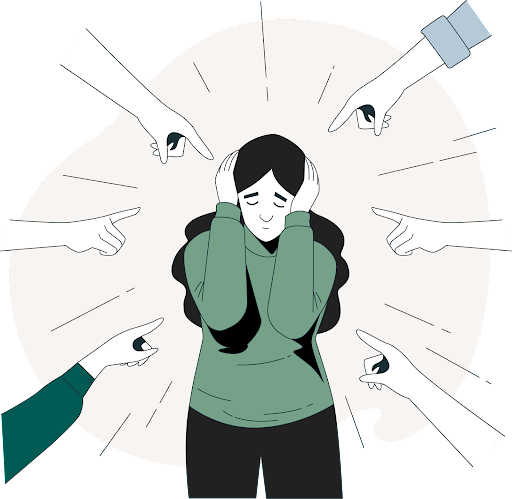
Let’s be clear though NO CEO or Executive Director wakes up daily with the sole intention of leading a non-inclusive, less equitable, and not diverse organization (and if they are, they aren’t saying this “quiet part” out loud).
Every leader wants to lead an organization where recruitment and retention are thriving, the culture excites people to come and work towards our mission every day, and where operations are so seamless that everyone is proud to say, “This is what you experience by working with us.”
Instead, leaders find themselves in the hot seat, being bombarded with questions about DEI, culture, operations, and retention, trying to find answers, and feeling stuck alongside their team.
CEOs are watching talented people leave their organization, and others refuse to join it because they believe the experience they will have there is one that is non-diverse, non-equitable, and non-inclusive.
As the leader of a DEI consulting firm, it’s hard to watch DEI continue when all it’s causing is unraveling, disengagement, turmoil, and burdensome.
We can’t say DEI work matters unless we’re willing to deeply refine and define the work, something we haven’t done since the 1960s.
Three Honest Conversations to Have about Your Culture and DEI
After we admit to ourselves that we’ve been positioning DEI as both a solution and a problem . . . instead of using it to solve the root cause issues that can make or break an organization, leaders must have these three conversations:
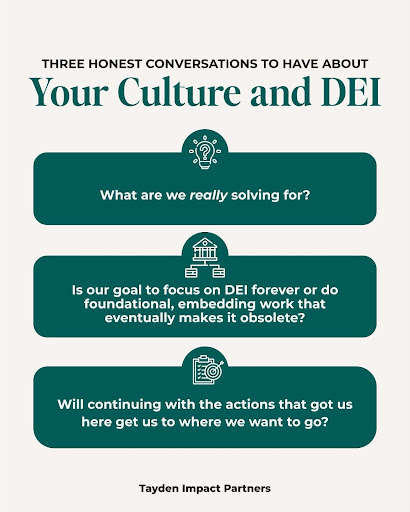
1. What are we really solving for?
Peter Drucker famously coined the phrase, “ Culture eats strategy for breakfast” and I would argue that it also eats an impact organization’s ability to do just that: make an impact.
Organizations must understand that with a shift in power from employer to employee, there needs to be an emphasis on the culture if they want to achieve the business results they’ve set forth:
It means that no matter how good your strategy is, your culture is unlikely to succeed if your culture is not aligned with it.
Culture is the foundation of an organization, identifying the shared values, beliefs, and behaviors that shape how people work together and how employees approach their work.
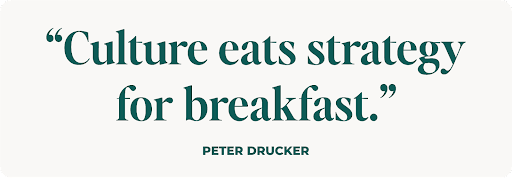
If an organization has a culture that values DEI, innovation, and risk-taking, employees are more likely to be creative and take risks.
In contrast, if an organization has cultural values of assimilation, conformity, and following rules, employees may be less likely to take risks, try new things, and bring their authentic selves to work.
This can impact the success of a strategy, as a strategy that requires innovation and risk-taking may need help to succeed in a culture that values conformity.
Organizations that haven’t embraced this shift of bringing DEI into their culture and strategy are now experiencing an inability to consistently recruit and retain the quality of teams who can deliver on their strategy. And when an organization spends a disproportionate amount of time trying to recruit, retain, and strengthen its working culture, they lose the ability to work toward its mission.

The issue isn’t really about DEI.
It’s that post-pandemic, we are no longer the workplaces and workforce we once were. We are now in a place where people and work have changed, and it’s time we face this.

Organizations must now focus on ensuring their ‘insides match their outsides’ and investing in their internal infrastructures and experience like they do their client work. Otherwise, it will be felt by the team and the clients and ultimately impact the ability to do the work that is so needed in many places.
2. Is our goal to focus on DEI forever or do foundational, embedding work that eventually makes it obsolete?
Roosevelt Thomas Jr. first introduced the idea of a shift of the approach in his thoughts on “Affirmative Action to Affirming Diversity,” noting:
In recent years, more DEI leaders have begun to have a new set of conversations centered on how to operationalize DEI. In the article “The Five Stages of DEI Maturity,” Ella Washington outlines the predictable stages organizations tend to follow in their DEI journey, with stage 5 being Sustainable, in which “organizations whose DEI efforts are deeply embedded in their corporate DNA have entered the sustainable stage. Their DEI efforts pass stress tests such as economic challenges and changes in leadership, and their leaders have a mindset of continuous improvement.”
I believe our role as DEI partners is to make DEI work obsolete (similar to Washington’s 5th stage). But, if organizations continue to think that setting up a series of DEI initiatives, instituting a new program here and there, and hiring a few team members is the right approach to get the organization to stage 5, they will continue to fall short.

DEI is not a finite set of projects on a checklist for an organization to get through. It is a state of being that organizations can reach, and when they do, they will make project-based DEI obsolete.
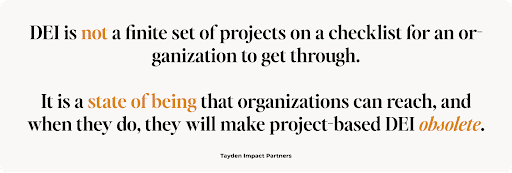
DEI is the core way in which a business should fundamentally operate.
Similar to how a person has things fundamental to their personality and way of being—they don’t have to “hack” themselves into doing things a certain way; they just do.
Authors Kwon and Nikoladies describe this shift as incorporating triple-loop learning into diversity, in which “values of diversity are expected to be embedded in the process of organizational growth through continuous learning moment-by-moment. One possible scenario is that diversity per se is reframed as a mission and vision of the organization. The boundary between majority and minority is collapsed, and diversity becomes the evolving purpose of the organization’s existence.”
It is not impossible; we’ve just misunderstood where we should be headed.
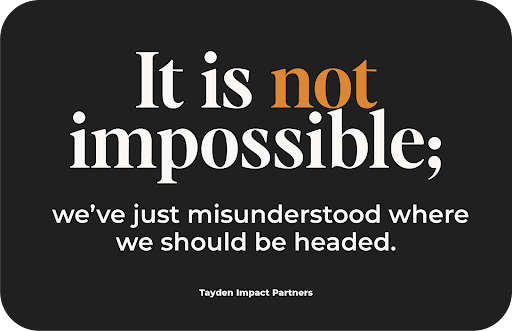
If we want to lead and operate organizations where people experience a culture where they want to stay longer, apply to work there, and, when they are there, have an experience so inclusive and influential that they provide the best results towards the mission…
We have got to start asking ourselves a different question.
Instead of asking how we launch more DEI initiatives, ask this instead:
What would need to be true for DEI to no longer exist as an initiative, program, or function but rather as the way of operating a best-in-class organization?
DEI can and should be seen as a way of doing business, making DEI committees and leads obsolete because the work belongs to the organization rather than a designated group or person.
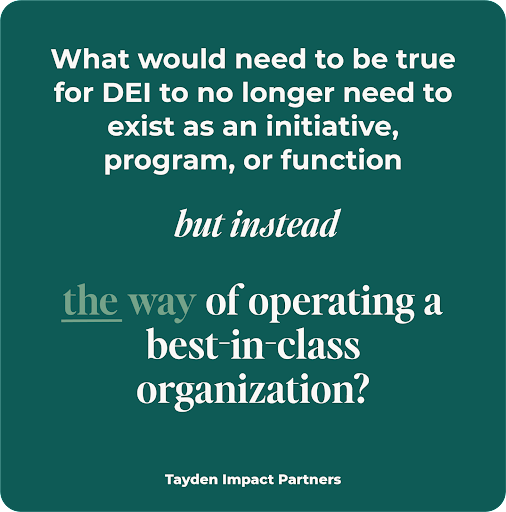
This will require organizations to take a fundamentally new set of steps to ensure this shift happens, with the understanding that to get to the place where DEI can be obsolete, there will need to be training, coaching, and immersive experiences for all staff first and not just a sudden announcement that “We have DEI figured out.”
3. Will continuing with the actions that got us here get us to where we want to go?
DEI strategies and organizational cultures were ripe for an overhaul before the pandemic hit, but everything was magnified or brought to the surface.
Organizational leaders must realize that what worked before (usually as a band-aid solution) no longer makes sense. And instead of continuing to try the same approaches, strategies, and behaviors, they need to use this time to build something new, something that allows their whole org to create workplaces aligned with their values, their mission, and the way they work….rooted in principles of diversity, equity, and inclusion.
With DEI, we are beginning to have the right conversation (“Let’s operationalize it!”), but our project-based approach still isn’t going to get us where we intend to go.
Instead, we must shift to DEI as the solution we build our organizational culture, integrating it into every business function, department, and strategy.
When DEI is integrated into an organization’s culture, it becomes a part of how people work together. It is not just a set of policies or programs but a way of thinking and behaving embedded in the organization’s values and practices. By prioritizing DEI, organizations can create a culture that values diversity, promotes equity, and supports the development of all employees.
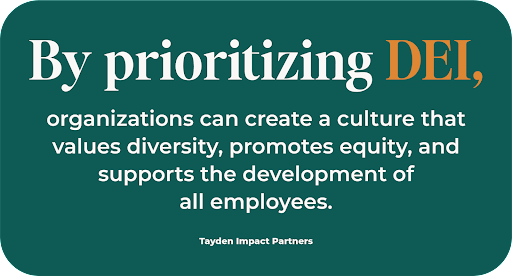
It’s easy to say this on paper to leaders nationwide and then say, “Go forth, have the conversations, and make the changes!”
But truth be told: organizations still need to function with their current day-to-day systems and behaviors. Change takes time, and we can’t expect organizations to stop doing business until they know how to shift.
It’s reminiscent of a building undergoing remodeling, where some of it still functions as it has been. Still, other parts are closed temporarily with signs saying, “Pardon our mess as we build new, better facilities for you.”
Pardon Our Mess as We Remodel
Here’s a wild thought: what if that is our solution to truly making DEI how we operate and not just a set of frustrating projects?
What if organizations could put these signs up across different business functions, little by little, as they figure out how to shift what once was?
What if this is how we make DEI (as we know it) obsolete?
If a hotel wants to both remodel and continue to make money, they close and remodel the pool first, then the business center and restaurant, then one wing of rooms, then the next, etc.
How can we pull from this “active remodeling” idea as mission-driven organizations that want to shift from DEI as projects to a way of operating and being?
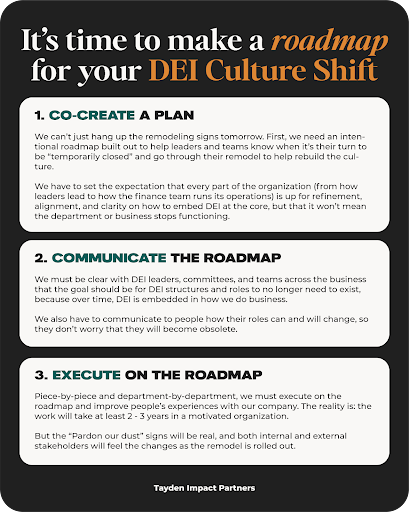
It’s time to make a roadmap.
For the “remodeling project” to be successful, we have to level-set with our organization that a shift is coming and that it begins with centering DEI as the main stage.
This means we need to co-create a roadmap with DEI leaders, consultants, executives, etc., communicate that roadmap, and execute it.
It’s the experience that matters and defines DEI.
Someone asked me recently to sum up DEI in one sentence, and I immediately knew my answer: “It’s what we experience while we are here.”
In any organization, recruitment, retention, and the quality of work are all impacted by what people experience as a part of the workplace culture. If they feel valued, included, and treated fairly, people tend to stay longer, engage deeper in the work, and be comfortable sharing quality referrals for the organization to recruit.
If they experience the opposite? You’re likely to see the impact through reviews on places like GlassDoor and feel the impact as the quality of work declines, applications to apply decline in diversity representation, and team members are too busy looking for their exit to focus on what’s happening internally.
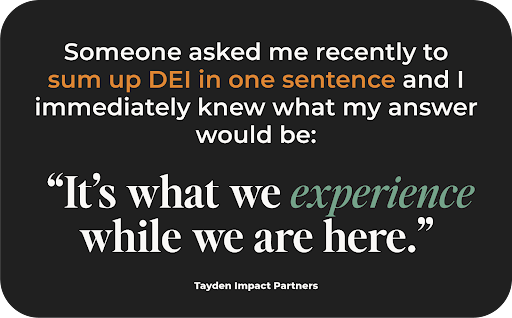
Even more concerning? The impact of a negative cultural experience on an individual can have lasting effects on their health, confidence, and ability to perform in future roles at their current and following organizations.
An antagonistic culture takes its toll on an organization for years to come. If we can reverse this, the positive impact that can be had on the workforce at large pays dividends.
The roadmap to making DEI obsolete starts and ends with recognizing that the road we’ve been on will no longer take us to the destination we were trying to reach. It’s time to try a new approach, route, and mode of transportation to build impact organizations whose insides match their outsides.
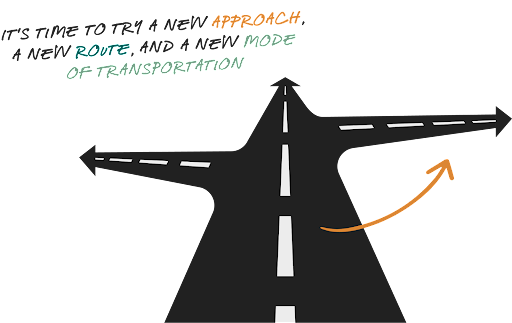
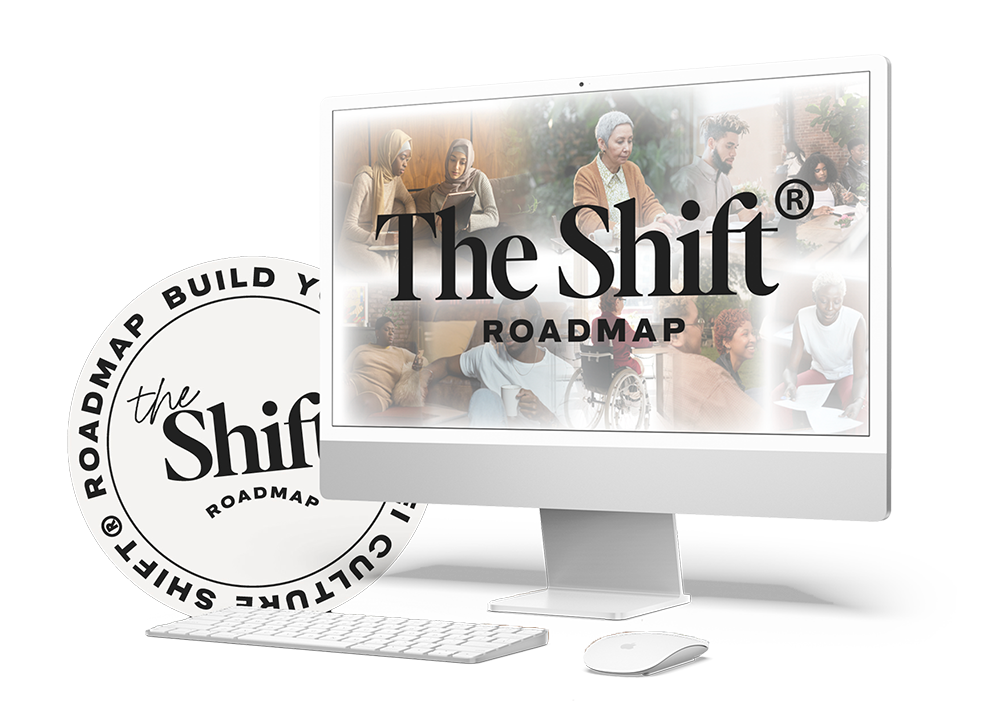
It’s time to make a roadmap for your DEI Culture Shift
We’ve developed a one-day, immersive experience for organizations ready to begin working on these core actions and would love a clear roadmap for how to get started.
You can sign up with four other team members for our next session below.
References
Cardoza, N. (2023/March). Companies Committed to DEI. Then, the Layoffs Started. Anti-Racism Daily.
Gonzales, M. (2023/March). Why Are DEI Roles Disappearing? SHRM.
Kwon, C. and Nicolaides, A. Managing Diversity Through Triple-Loop Learning: A Call for Paradigm Shift. Human Resources Development Review. 2017. Vol.16 (I) 85-99
Melaku, T.M. and Winkler, C. (2022/June). Are Your Organization’s DEI Efforts Superficial or Structural? Harvard Business Review.
Osibanjo, R. (2022/February). The Post-Pandemic Workplace: 5 Shifts Every Leader Must Make. Forbes.
The Alternative Board. (2020/February). Culture Eats Strategy for Breakfast. What Does it Mean?
Thomas, Jr, R. Roosevelt. (1990/March-April). From Affirmative Action to Affirming Diversity. Harvard Business Review.
Tran, K. (2021/March). The Diversity and Inclusion Industry Has Lost Its Way—Harper’s Bazaar.
Washington, E. F. (2022/November-December). The Five Stages of DEI Maturity. Harvard Business Review.


